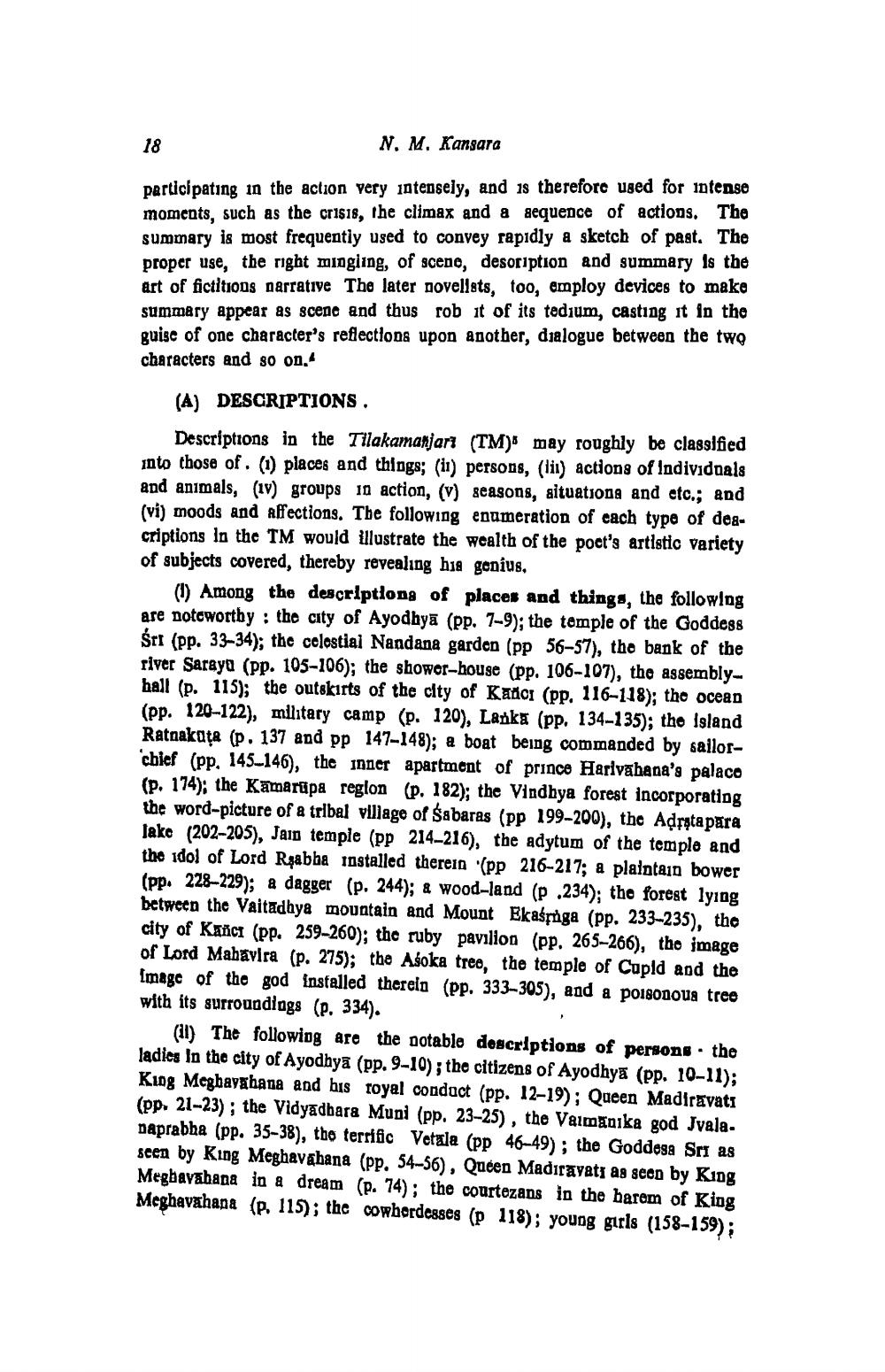________________
N. M. Kansara
participating in the action very intensely, and is therefore used for intense moments, such as the cr1918, the climax and a sequence of actions. The summary is most frequentiy used to convey rapidly a sketch of past. The proper use, the right mingiing, of sceno, desoription and summary is the art of fictitions narrative The later novelists, too, employ devices to make summary appear as scene and thus robit of its tedium, casting it in the guise of one character's reflections upon another, dialogue between the two characters and so on.
(A) DESCRIPTIONS.
Descriptions in the Tilakamanjani (TM) may roughly be classified into those of. (1) places and things; (i) persons, (iii) actions of Individuals and animals, (10) groups 10 action, (v) seasons, situations and etc.; and (vi) moods and Affections. The following enumeration of each type of deacriptions in the TM would illustrate the wealth of the poet's artistic variety of subjects covered, thereby revealing his genius,
(1) Among the descriptions of places and things, the following are noteworthy : the city of Ayodhyā (pp. 7-9); the temple of the Goddess Śrt (pp. 33-34); the celestial Nandana garden (pp 56-57), the bank of the river Sarayo (pp. 105-106); the shower-house (pp. 106-107), the assemblyhall (p. 115); the outskirts of the city of Kanci (pp. 116-118); the ocean (pp. 120-122), military camp (p. 120), Lanka (pp. 134-135); the Island Ratnakata (p. 137 and pp 147-148); a boat being commanded by sailorchief (pp. 145_146), the inner apartment of prince Harivahana's palaco (p. 174); the Kamarupa region (p. 182); the Vindhya forest incorporating the word-picture of a tribal village of Sabaras (pp 199-200), the Adrsta para Jake (202–205), Jai temple (pp 214-216), the adytum of the temple and the idol of Lord Rşabba installed therein (pp 216-217; a plaintain bower (pp. 228-229); a dagger (p. 244); & wood-land (P .234); the forest lying between the Vaitadhya mountain and Mount Ekaśmiga (pp. 233-235), the city of Kance (pp. 259-260); the ruby pavilion (pp. 265-266), the image of Lord Mahavira (p. 275); the Asoka treo, the temple of Cupid and the Image of the god installed therein (pp. 333-305), and a poisonoua tree with its surroundings (p. 334).
(1) The following are the potable descriptions of persons. the ladies in the city of Ayodhyā (pp. 9-10); the citizens of Ayodhyā (pp. 10-11); Klog Meghayuhana and his royal conduct (pp. 12-19); Queen Madiravati (pp. 21-23); the Vidyadbara Muni (pp. 23-25), the Vaimnika god Jvala. paprabha (pp. 35-38), the terrific Vetala (pp 46-49); the Goddesa Sri as seen by King Meghavahana (pp. 54-56), Queen Madiravats as seen by King Megbayabana in a dream (p. 74); the courtezans in the barem of King Meghavahana (p. 115); the cowbordc88es (p 118); young girls (158-159);




